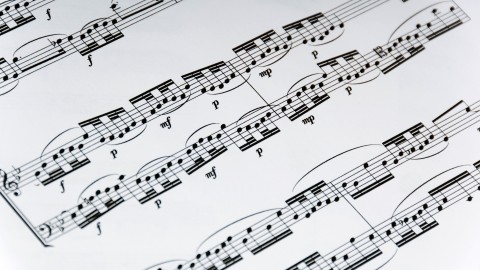
Intermediate Music Theory – Hands-On Approach
Intermediate Music Theory – Hands-On Approach, available at $34.99, has an average rating of 4.3, with 15 lectures, 6 quizzes, based on 13 reviews, and has 188 subscribers.
You will learn about By the end of the course the student will be able to recognize intervals, understand and find the keys with flats and sharps; understand the sixteenth note, rest, the dotted eight note, the "alla breve" term and what syncopation is. This course is ideal for individuals who are The course is designed for 12 year olds and up that read music and play the piano and are willing to sit down and do the homework provided for each lesson. or Teachers also are encouraged to use this course in their music instruction. Homework and outlines are already planned and available for download. It is particularly useful for The course is designed for 12 year olds and up that read music and play the piano and are willing to sit down and do the homework provided for each lesson. or Teachers also are encouraged to use this course in their music instruction. Homework and outlines are already planned and available for download.
Enroll now: Intermediate Music Theory – Hands-On Approach
Summary
Title: Intermediate Music Theory – Hands-On Approach
Price: $34.99
Average Rating: 4.3
Number of Lectures: 15
Number of Quizzes: 6
Number of Published Lectures: 15
Number of Published Quizzes: 6
Number of Curriculum Items: 21
Number of Published Curriculum Objects: 21
Original Price: $69.99
Quality Status: approved
Status: Live
What You Will Learn
- By the end of the course the student will be able to recognize intervals, understand and find the keys with flats and sharps; understand the sixteenth note, rest, the dotted eight note, the "alla breve" term and what syncopation is.
Who Should Attend
- The course is designed for 12 year olds and up that read music and play the piano and are willing to sit down and do the homework provided for each lesson.
- Teachers also are encouraged to use this course in their music instruction. Homework and outlines are already planned and available for download.
Target Audiences
- The course is designed for 12 year olds and up that read music and play the piano and are willing to sit down and do the homework provided for each lesson.
- Teachers also are encouraged to use this course in their music instruction. Homework and outlines are already planned and available for download.
Have you ever wanted to understand the jargon of music? Or have you wished to understand the music that you are playing in the deeper and more meaningful way?
This intermediate music theory course will help the student understand how music is structured in relation to keys, intervals and rhythm. The course is built to provide step by step information in a logical and systematical way. Unlike many others, this is hands-on course.
Each lesson includes a video presentation, a PDF presentation that the student can print for review, a worksheet and the answer sheet. By the time you print all the documents, you will have a nice booklet with all the information that you can always refer back to and hands-on assignments that are invaluable since they help solidify the concepts learned in the video. The student should answer the question in the worksheet and check his/her work with the answer sheet. I highly recommend that the student does not skip the assignment sheets. Music theory is learned by doing it.
This course will cover:
- Half Steps & Whole Steps
- Intervals
- Key Signatures
- Flat & Sharp Keys
- Tetrachords
- Major Scales
- The Circle of Keys
- Sixteenth Notes & Rests
- The Dotted Eight Note
- Alla Breve
- 3/8, 6/8, 9/8, 12/8 Time Signatures
- Syncopation
Music theory is very important for a musician; it gives us a better understanding of the music we are performing and a structural platform for improvisation. It helps us to sight read, transpose, improvise, compose, and perform better. If you understand the theory behind the music, it will help you perform the piece with a deeper knowledge. Theory is the grammar of the musical language and we need to know it in order to speak the language of music correctly. It helps us understand how music fits together and why it sounds the way it does.
Prerequisites:
Be able to read music and play the piano.
Understand the staff, the clefs; know the letter names of all the notes, understand the measure and how to count the whole, half, quarter, eight notes and the dotted half and quarter notes and all the rests for these notes; understand the repeat signs, first and second endings; the tie and the slur; flats, sharps and accidentals.
I am looking forward to help you in any way I can. I have been a professional piano teacher for over 25 years and played the piano in many concerts, recitals, accompanying and conducting choirs over the year. I have written many pieces for choir and small ensemble and orchestrated and recorded many CDs. I will do my outmost to help you understand the topics in this course. Just ask if you need any help!
Enroll today and start learning music theory online! You will be empowered in your musicianship, performance and understanding of the language of music. Thank you for taking my course.
Course Curriculum
Chapter 1: Overview
Lecture 1: Course Overview
Chapter 2: Learning About Keys
Lecture 1: Half Steps & Whole Steps
Lecture 2: Intervals
Lecture 3: Key Signatures
Lecture 4: Flat Keys
Lecture 5: Sharp Keys
Lecture 6: Tetrachords
Lecture 7: Major Scales
Lecture 8: The Circle of Keys
Chapter 3: Rhythm
Lecture 1: Sixteenth Notes & Rests
Lecture 2: The Dotted Eight Note
Lecture 3: Alla Breve
Lecture 4: 3/8, 6/8, 9/8 & 12/8 Time Signatures
Lecture 5: Syncopation
Chapter 4: Review
Lecture 1: Final Review
Instructors
-
Mihaela Williams
Music Teacher, BM in Music Composition, Pianist
Rating Distribution
- 1 stars: 1 votes
- 2 stars: 0 votes
- 3 stars: 1 votes
- 4 stars: 3 votes
- 5 stars: 8 votes
Frequently Asked Questions
How long do I have access to the course materials?
You can view and review the lecture materials indefinitely, like an on-demand channel.
Can I take my courses with me wherever I go?
Definitely! If you have an internet connection, courses on Udemy are available on any device at any time. If you don’t have an internet connection, some instructors also let their students download course lectures. That’s up to the instructor though, so make sure you get on their good side!
You may also like
- Best Public Speaking Courses to Learn in March 2025
- Best Affiliate Marketing Courses to Learn in March 2025
- Best Email Marketing Courses to Learn in March 2025
- Best Social Media Management Courses to Learn in March 2025
- Best SEO Optimization Courses to Learn in March 2025
- Best Content Creation Courses to Learn in March 2025
- Best Game Development Courses to Learn in March 2025
- Best Software Testing Courses to Learn in March 2025
- Best Big Data Courses to Learn in March 2025
- Best Internet Of Things Courses to Learn in March 2025
- Best Quantum Computing Courses to Learn in March 2025
- Best Cloud Computing Courses to Learn in March 2025
- Best 3d Modeling Courses to Learn in March 2025
- Best Mobile App Development Courses to Learn in March 2025
- Best Graphic Design Courses to Learn in March 2025
- Best Videography Courses to Learn in March 2025
- Best Photography Courses to Learn in March 2025
- Best Language Learning Courses to Learn in March 2025
- Best Product Management Courses to Learn in March 2025
- Best Investing Courses to Learn in March 2025






















